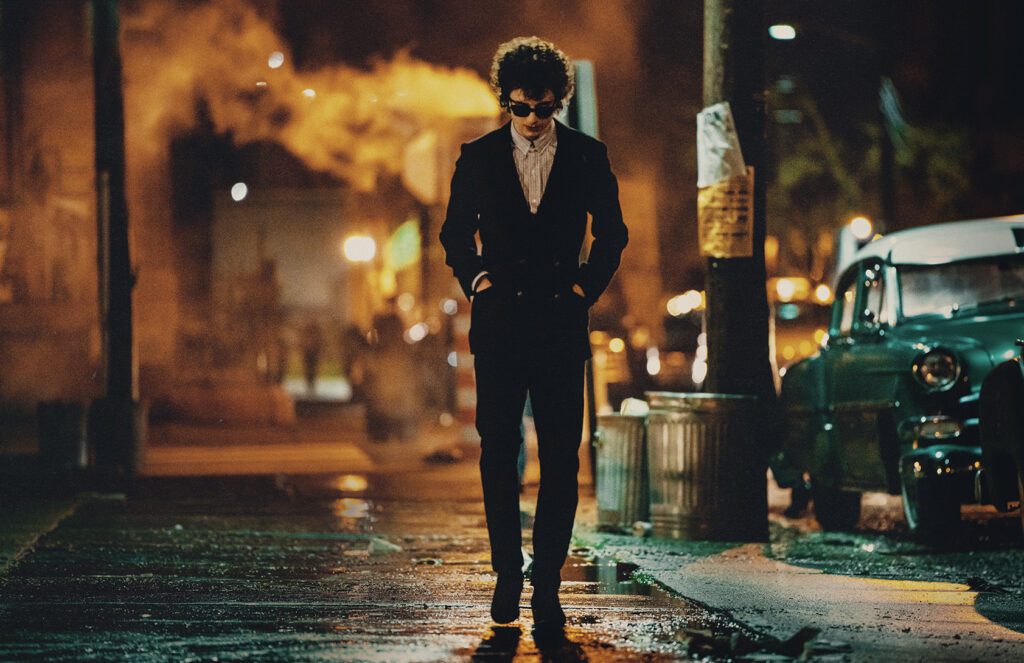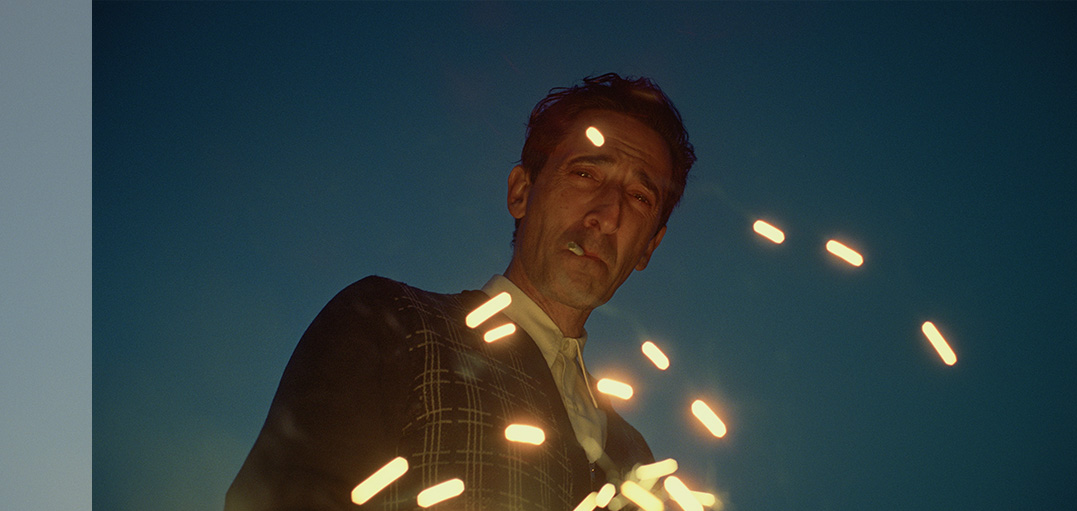It takes a confident filmmaker to make a film like The Brutalist. I don’t mean in its sense of scale and length, though this film looks like it cost more than the 10 million U.S. dollars it did, and it tracks for just a little over 3 hours and 30 minutes. The Brutalist needs a confident filmmaker because of what he’s trying to say and how it conveys its direct but effortlessly complex message. So it’s a surprise that someone like Brady Corbet was approaching this – and then again, perhaps it needed someone like Corbet.
I’m not particularly familiar with Corbet’s oeuvre. I have always been curious about The Childhood of a Leader, where he explores the genesis of evil in a child after World War I. And remember, Vox Lux’s reception was so lukewarm its international release was truncated. For all that is worth, Corbet has devoted fans who believe in his talent. I only knew him from his acting work, especially in Michael Haneke’s remake of Funny Games or Lars Von Trier’s Melancholia. Oh, he was in Martha Marcia May Marlene, that’s a terrific film. And has a little scene in Ruben Östlund’s Force Majeure? He worked with Mia Hansen-Løve, Olivier Assayas and Noah Baumbach as well? Those are some of the best modern auteurs currently working.
The Brutalist tells the story of Lázlo Tóth (Adrien Brody), a Hungarian Jewish architect refugee in America. He left his wife Erzsébet (Felicity Jones) in Hungary as he tried to make a name for himself in the country before bringing her in. After a couple of setbacks with family and a stint working in construction, he catches the eye of a wealthy philanthropist named Harrison Lee Van Buren Sr. (Guy Pearce), who commissions Lázlo to build a vanity project of his – a gargantuan cultural and sports centre, part theatre, part gymnasium, and part church, that serves as a cultural hub for their small community.
By the point we meet Tóth, he’s already an established artist, so there’s nothing left for him to prove to anyone. He’s quiet and determined, and because of that, we learn little about his opinion on the political turmoil surrounding him. Corbet uses the film’s first half to set up a real immigrant experience. The one of someone who needs to settle in a new environment and constantly remain apolitical. Near the mid-point, talking to Van Buren, Tóth uncharacteristically opens up by telling a tale of the buildings he created back in his home country. The poetic tone hides an indictment of the people who misunderstand and re-appropriate his work. “I already anticipate a communal rhetoric of anger and hear (…), but my buildings were devised to endure such erosion of the Danube’s shoreline”, he says to a Van Buren who, ironically, doesn’t seem to grasp what he’s trying to say.
This idea, if the artist’s ethos present in his work is repurposed to whoever comes next, surrounds the film’s most nuanced point – the reaction to the the establishment of the State of Israel. In the first act, Tóth works hard while listening to Ben Gurion’s speech at the United Nations, not even acknowledging the geopolitical storm brewing around him. He’s a practising Jewish man who doesn’t even consider the thought of Israel as a safe haven for him – the only opinion the film yanks off him is a disapproving nod to a family member moving there. Yet, Tóth would have all the right to see the new country as a comforting. In America, he’s fooled, forgotten, patronised, and tricked. The same benefactor that protects him, who represents the American economic and political establishment whose faith wouldn’t have changed regardless of the outcome of World War II, commits an act so heinous it shakes the foundation of Tóth as a safe immigrant. And even then, America stands as his home. The irony of the end is that his drunken words come back as prophetic.
The Brutalist is a complex film expertly directed by Corbet on top of his game. It’s part There Will Be Blood via Ingmar Bergman, Renoir and Bertolucci. There’s a whole sequence in an Italian Marble Quarry, a background so clean and yet unforgiving each shot was blowing my mind. In there, he meets an old Italian friend who recreates Lázlo’s own hubris – that whatever happens, he’ll survive out of his stubbornness alone. What others will say about him is superfluous to what he leaves behind.
And that’s the majesty of this film. Even that school of architecture has something to be decoded – it remains a style that celebrates mankind in a communal way, where society’s classes stand on the same ground, surrounded by the same concrete. Corbet made a big film here, with big ideas, that people will discuss and analyse for years. It’s not direct; it demands attention. There’s a helpful intermission halfway through 15 minutes, a welcoming point to gather our thoughts before facing the rest. It’s a film that encompasses what it is to be an immigrant but does it through the frame of an artist coming to peace with his voice, regardless of what everyone says that is – and yes, I understand the irony of being a film critic analysing a film through that frame, but I’m also comfortable with that.
Verdict: 5 out of 5
For anyone who believes cinema could be long, dense, and layered, this is a Camusian examination of an immigrant artist whose place is defined by his work, not his location.

A Complete Unknown
Martin Scorsese’s Raging Bull is the only biopic worth watching. Partially because it doesn’t sacrifice the poetry of its images to represent its subject. Other biopics are fine – last year’s Oppenheimer deserved most of its accolades, and James Mangold’s Walk The Line is an enjoyable piece of popcorn cinema – but overall, they are useless. What can be told in two hours that represents the life of a famous person that can’t be said by the fictionalised account of a character made specifically for a film? A biopic is hampered by the portrayal of its characters, having to be primarily sympathetic to them, except for showing flaws, as if that adds complexity. They are marketing tools and ad campaigns to sell albums or memoirs. Most of the time, they say nothing about the subject. Double so if the subject is one of modern folk music’s most recluse and mysterious people.
A Complete Unknown does little to change our opinion about biopics. It starts with a young Bob Dylan (Timothée Chalamet) arriving in New York, where he meets Pete Seeger (Edward Norton). We witness the rise and rise of young Bob, from his romance with Sylvie Russo (Elle Fanning), his relationship with Joan Baez (Monica Barbaro), and how he tapped into the folk zeitgeist of the epoch, all the way until the defining moment of going electric during the Newport Folk Festival before the release of Highway 61 Revisited.
Mangold plays the legend with the delicacy of a historian – with biased sentimentality and little philosophical acumen. All the famous stories are here, but they are rendered meaningless because there is no thematic thread tying them together. The third act, centred around the build towards the folk festival, at least has a raison d’être, but it’s too little too late for a film so anaemic.
Chalamet is fine as Bob. There’s a weird pantomime to his performance, but you can see he enjoys and respects the character. Norton is as tragic as Seeger, but the film does him wrong by portraying him as a lovable doofus stuck to the past. I enjoyed Barbaro as Baez, but again, the film isn’t sympathetic to the singer, which is particularly unfair in that egregious case.
Ask yourself why you are watching this film. Dylan fans know enough about it to keep the mystery alive, so any recreation comes across as cheap. Chalamet fans don’t care enough about Dylan or the many nerdy details and Easter eggs with which Mangold populates the film. Some are pretty ok (like a diss on Donovan coming out of nowhere), but others are eye-rolling poor (like Dylan playing the chords of Don’t Think Twice It’s Alright during a breakup scene), and some that are downright lazy (the famous moment someone shouted “Judas” in his concert in Glasgow is here moved to the Newport festival). Todd Haynes already released the quintessential Bob Dylan bio-something in I’m Not There, where different actors (including Cate Blanchett, Richard Gere, Heathe Ledger, and a young African American boy) play Dylan in various stages of his life. It’s cryptic, complex, confusing and compelling like the singer is. It’s not polished, pedestrian and plain like this film.
You can tell much about a person from their favourite Bob Dylan record. Mine is “Self-portrait. The often maligned project is an imperfect piece of music that combines some originals, some covers, lazy live versions of his songs, and a cover of Simon & Garfunkel’s The Boxer that sounds like Dylan is taking the mickey. That records starts with a lovely song called “All the tired horses”, that Dylan doesn’t even sing, instead a choir of female voices chant the same poem over and over – “all the tired horses in the sun //How’m I s’posed to get any riding‘done”. You learn more about Bob Dylan from that record than from this film. Ironically, A Complete Unknown is released in Australia at the same time as The Brutalist – a movie about an artist coming to terms with how every generation will perceive differently and ultimately misinterpret his body of work. That’s a lesson Mangold should have paid attention to instead of staying in the sun.
Verdict: 2.5 out of 5
For Gen-Zers who only just heard of Bob Dylan. And Chalamet fans – this is not his best performance, but his charisma is visibly growing. If you want to decode the artist, you’ll do better to watch I’m Not There or the D.A. Pennebaker documentary Don’t Look Back. Or watch the Sam Peckinpah western Pat Garrett and Billy The Kid, in which Dylan plays a mysterious man named Alias, a fictional character that represents the zeitgeist of its era. Nothing more Dylan that that.



